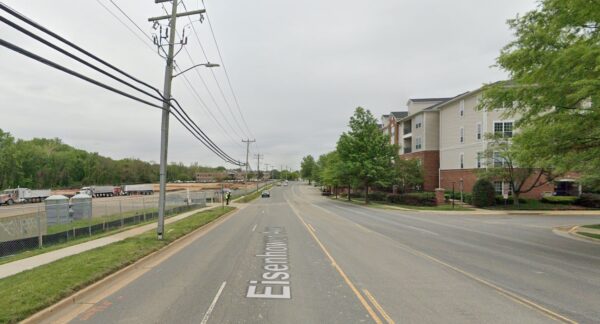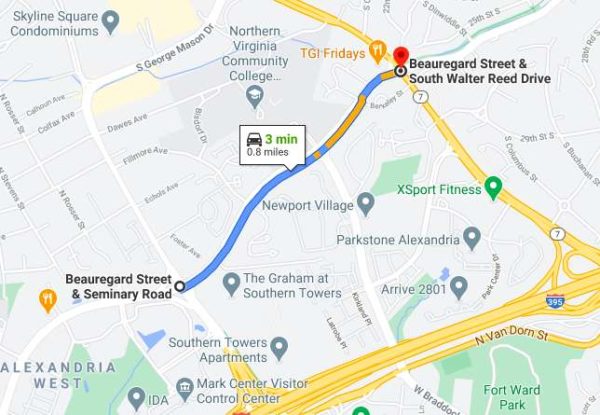Alexandria is seeking community feedback on a series of changes to South Pickett Street in the West End, including new pedestrian safety measures and protected bike lanes.
The project would cover S. Pickett Street from Duke Street down to Edsall Road. That route along the West End Village shopping center, Hillwood Condominiums, and ends near Samuel Tucker Elementary School.
“Today, South Pickett Street serves fast-moving vehicular traffic, has very few pedestrian crossings despite a robust crossing demand, and has no bicycle facilities,” a city report said. “This corridor has gradually been redeveloping into a higher-density neighborhood conducive to non-automobile travel, but the existing street design is challenging and hostile for people walking, biking, and taking transit.”
The road, currently four lanes, could be cut to two lanes for car traffic, one center-running turn lane, and a protected bike lane on each side of the street.
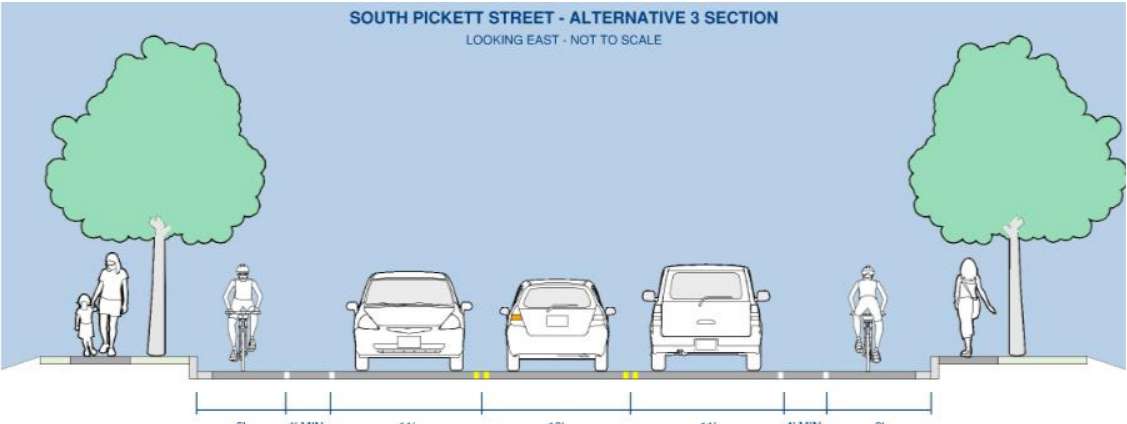
The report said “no significant differences in traffic operations” was expected based on a traffic analysis.
Other proposed changes include:
- Dedicated center turning lane
- Posted speed limit reduction to 25 mph
- New pedestrian crossings at key locations
- Traffic calming measures
- Upgrades to pedestrian ramps
- Lead Pedestrian Intervals and no turn on red restrictions at signalized intersections
Feedback can be submitted online until May 5. A virtual community meeting on the project is scheduled for Thursday, April 25 at 7 p.m. The meeting ID is 968 5930 1979 and the passcode is 968 5930 1979.
Following community feedback, the city said recommendations will be sent to the Traffic and Parking Board later this spring or this summer.
Image via Google Maps
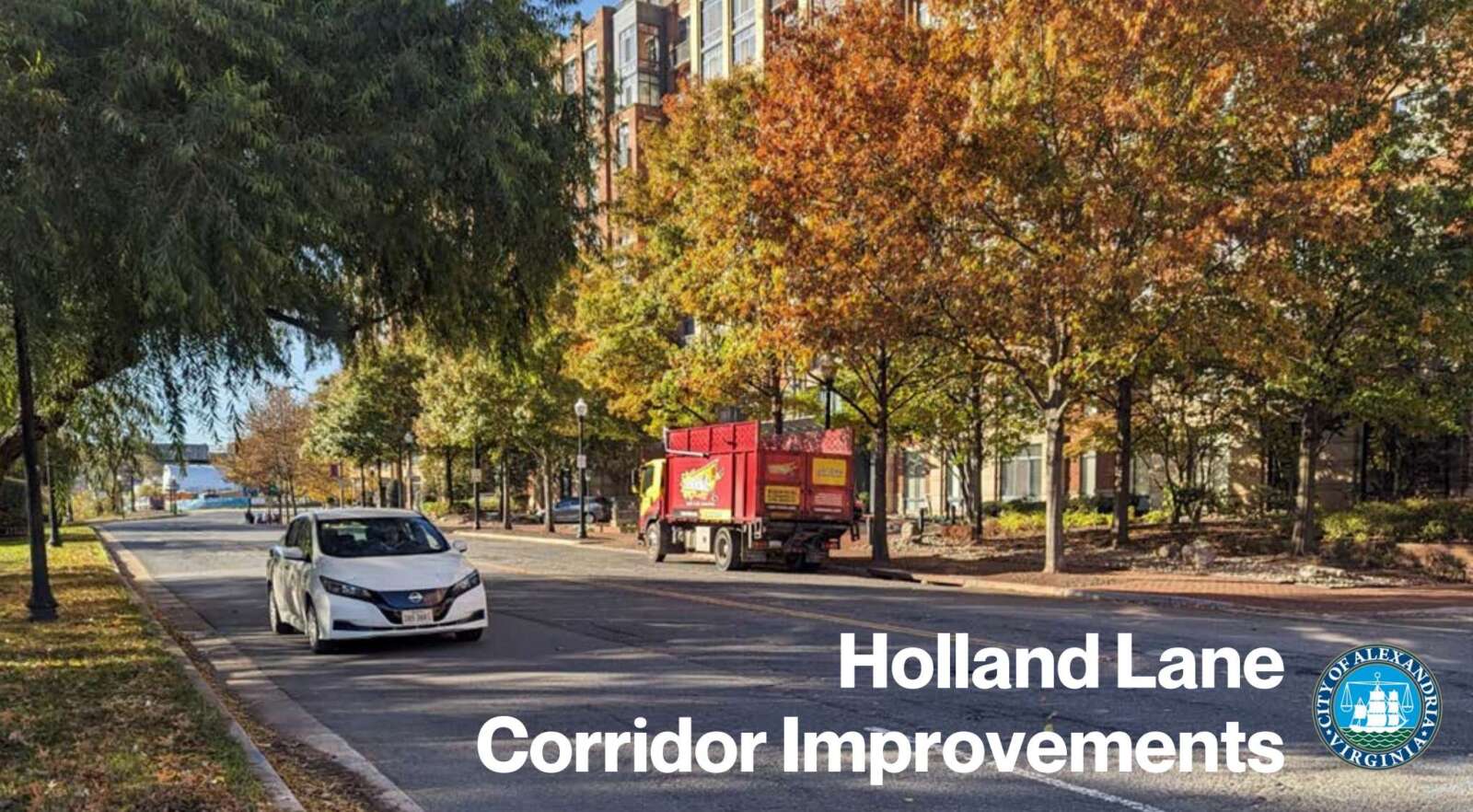
Holland Lane isn’t one of the longest or most-used streets in Alexandria, but it’s a major connection between the Old Town and Carlyle neighborhoods that may be getting a slight overhaul soon.
The City of Alexandria is currently gathering community feedback on plans that include, among other things, a bike lane on Holland Lane.
The street, which runs from Eisenhower Avenue up to the Whole Foods on Duke Street, is four lanes for most of its length and five at the Duke Street intersection.
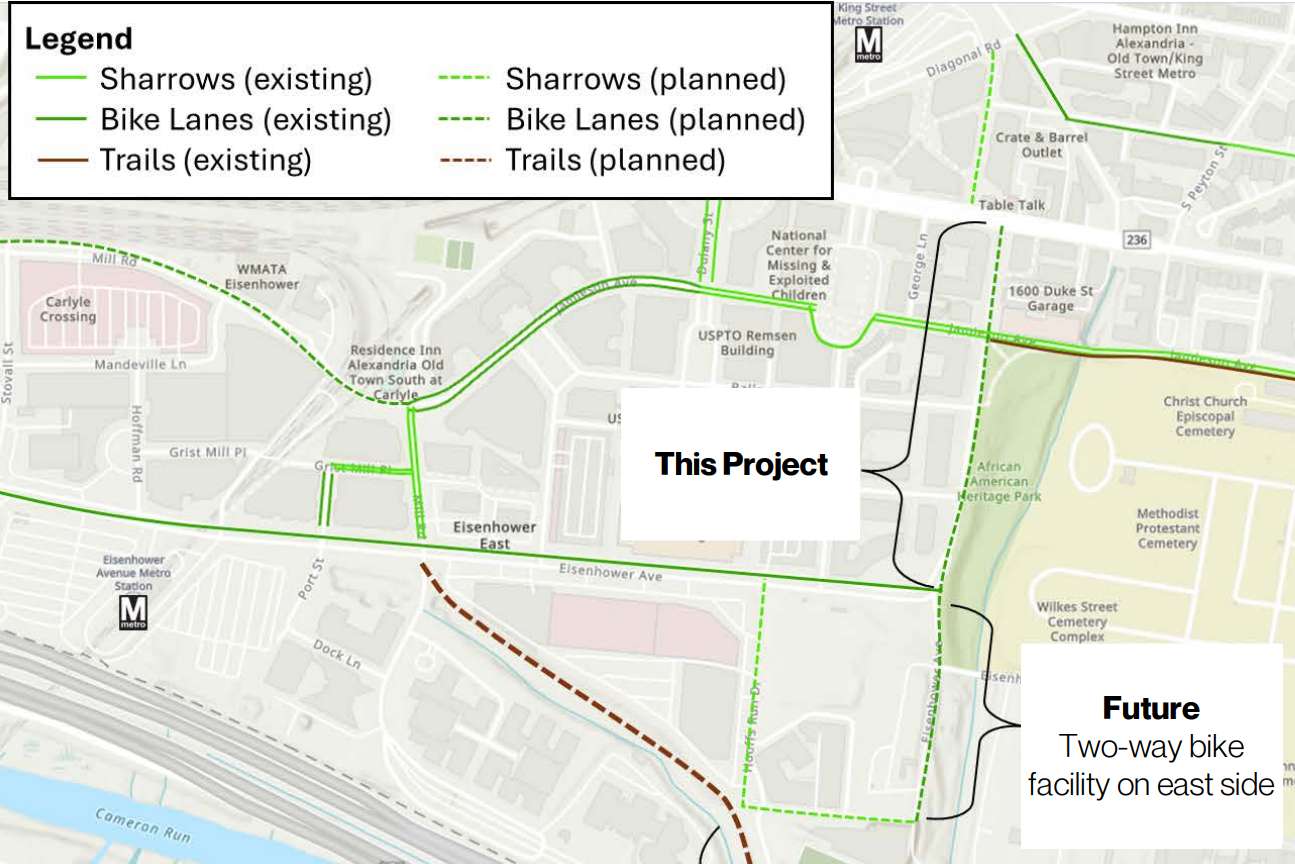
The street is in a highly dense area where a City presentation said up to 29% of drivers speed past the 25 mph limit by 5 mph or more. The City said there have been 13 crashes on Holland Lane since 2018 and six of those involved people walking, all of which resulted in injury.
There are four options presented for the project, but other than the no-build option, all of them involve installing bike lanes on one or both sides of the street.
Detailed design for the project is scheduled for summer-fall this year with implementation sometime next year.
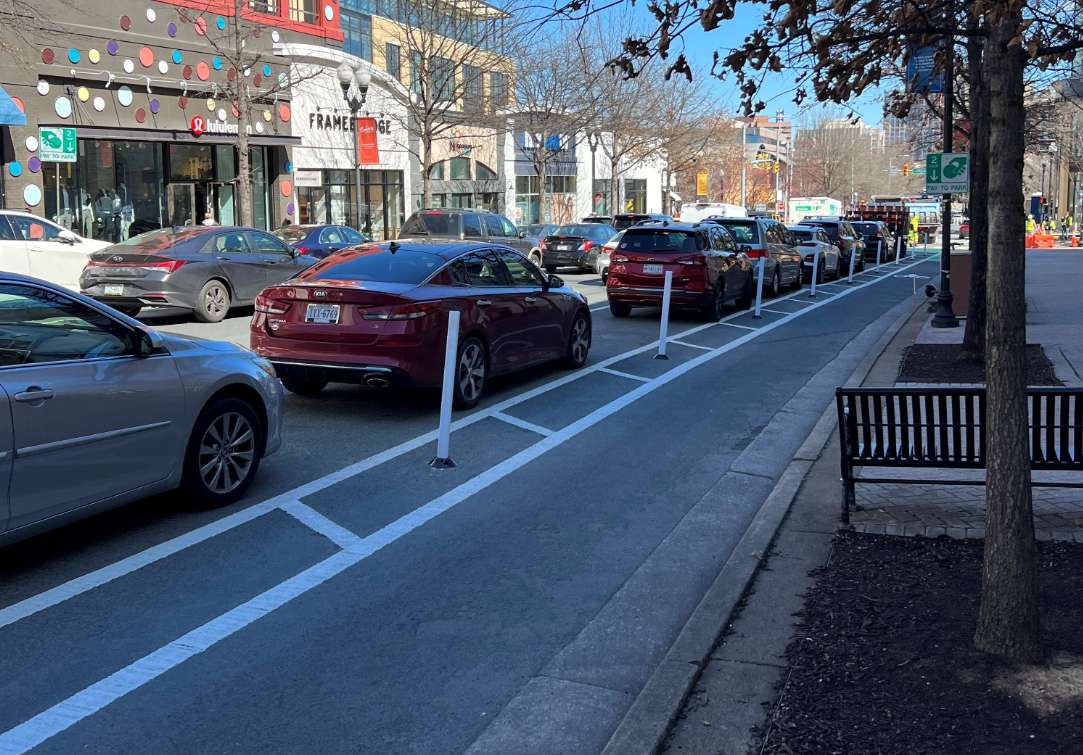
The City of Alexandria announced last week that four existing bike lanes will be getting new protection, including physical barriers, this summer.
Alexandria Transportation & Environmental Services announced the change last week — but it turned into a pretty busy news week after that.
The city will add four buffers to bike lanes on:
- King Street (Janneys Lane to Radford Street)
- North Van Dorn Street (Braddock Road to Menokin Drive)
- Pegram Street (Polk Avenue to North Pickett Street)
- Seminary Road (North Howard Street to Quaker Lane)
The City of Alexandria website said each of the streets currently has painted buffer zones but no physical barriers. While many of the physical barriers on bike lanes are obviously not strong enough to stop a car, it still provides a physical demarcation that helps keep drivers out of the bike lane.
While the Seminary Road bike lane conjures to mind heated discussion over traffic impacts, the city said the new barriers will have no impact on traffic.
The bike lanes are expected to be installed sometime this spring or summer.
This spring, the City will upgrade four existing bicycle lanes to protected bike lanes! By creating physical barriers between cyclists and the road, we’re improving safety for riders of all ages and abilities. Learn more about the upcoming projects: https://t.co/6hZJdlnKxh pic.twitter.com/KyjTegEGZh
— Alexandria Transportation & Environmental Services (@AlexandriaVATES) March 26, 2024
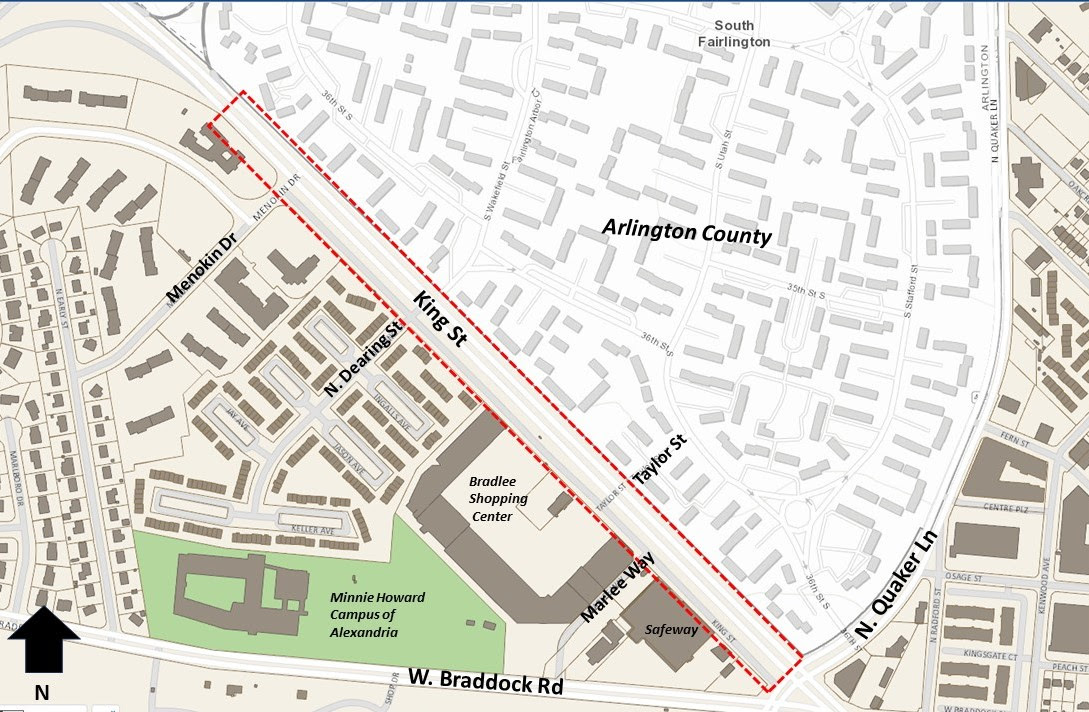
The Department of Transportation and Environmental Services (T&ES) is hosting an open house next week on safety enhancements planned for King Street.
T&ES is planning a series of changes along King Street near the Bradlee Shopping Center. A community meeting to discuss the changes is scheduled for 5-7 p.m. on Thursday, Feb. 15, at the Fairlington Presbyterian Church (3846 King Street).
Feedback collected by the city said the roadway is currently confusing and not very pedestrian friendly, with crosswalks on only one side of the street and some confusing intersection design, according to a presentation from city staff.
The changes, first announced late last year, could include bike lanes and more sidewalks along the road.
The plans to improve that stretch of King Street are particularly timely, with Alexandria City Public Schools (ACPS) leaders expressing concern about pedestrian safety in the area, especially with students walking back and forth between the two Alexandria City High School campuses.
The design process is set to kick off this spring and will run through Spring 2027.
Join us Thursday, February 15 for a Community Open House to learn about proposed safety enhancements to King Street between North Quaker Lane and Menokin Drive. To learn more about this project, visit https://t.co/F2KT97O7xu pic.twitter.com/CK529KEKVI
— Alexandria Transportation & Environmental Services (@AlexandriaVATES) February 5, 2024
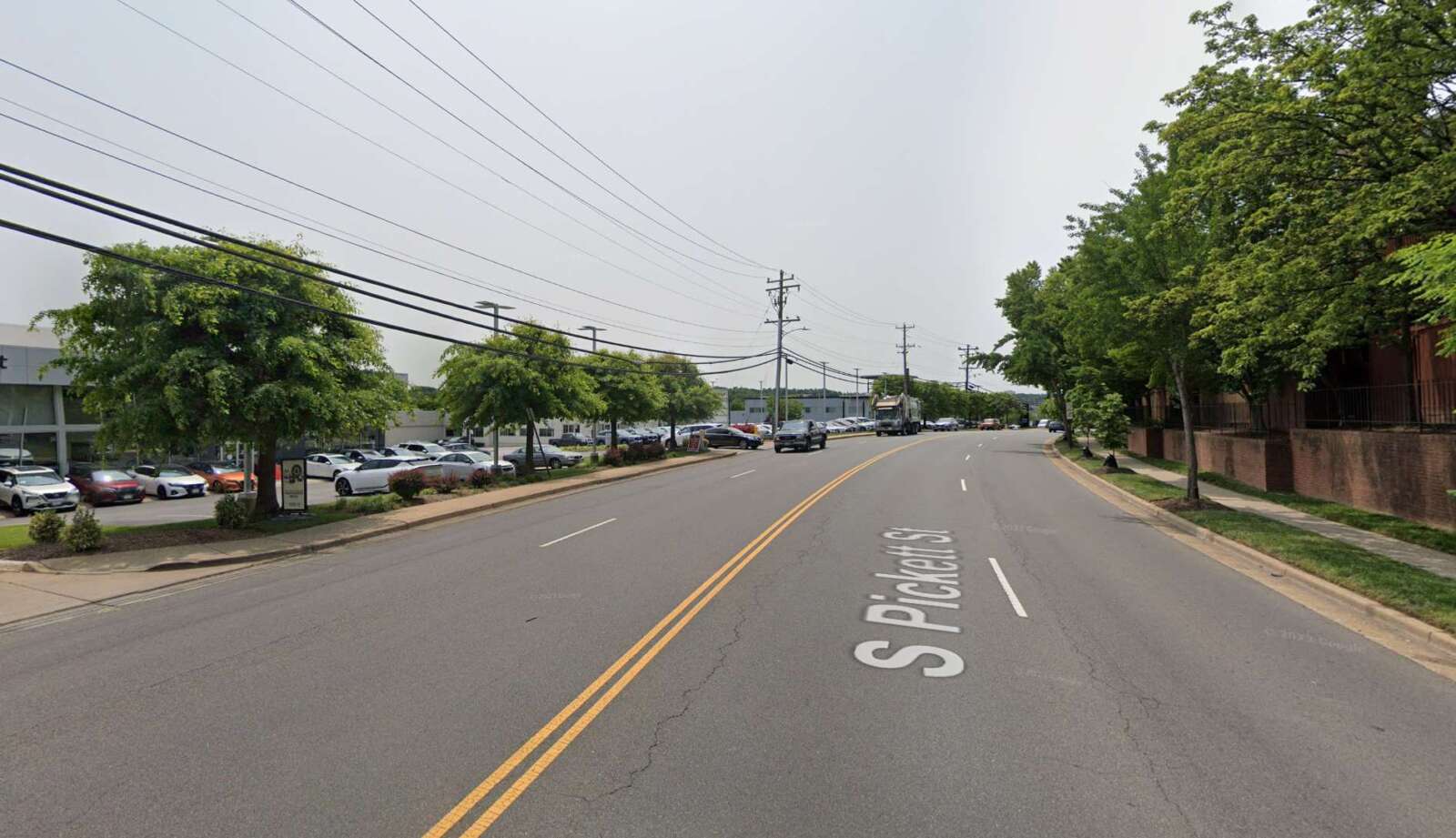
S. Pickett Street runs from Duke Street down past S. Van Dorn Street, and some of that road may soon have new bike lanes.
From Edsall Road up to Duke Street, past the West End Village shopping center and a series of condominiums, the city is considering bike lanes on the four-lane road.
According to the project website:
South Pickett Street is a four-lane roadway that provides access between Duke Street and Edsall Road. West of Edsall Road, it is a two-lane roadway with bike lanes and on-street parking. South Pickett Street features a mix of land uses, including high-density residential and commercial properties.
The Proposed Bicycle Network in the adopted Alexandria Mobility Plan calls for a dedicated bicycle facility on South Pickett Street. The City’s Complete Streets Five-Year Work Plan includes a project to evaluate bike lanes on South Pickett Street. A bike lane would not only improve safety for people biking, but could enhance safety for people driving, create opportunities for enhanced pedestrian crossings, and provide traffic calming.
An online feedback form includes a walkthrough of the site’s existing conditions, noting that bicycles in multiple places are forced to either ride in traffic in the street or on the sidewalk and multiple intersections have inadequate crosswalks.
The survey form asks readers how they travel on the road, issues they have with the corridor, and why they travel on S. Pickett Street. Finally, the survey asks what should be added or left unchanged to the street, and whether there were treatments on other streets that should be applied to S. Pickett Street.
Image via Google Maps
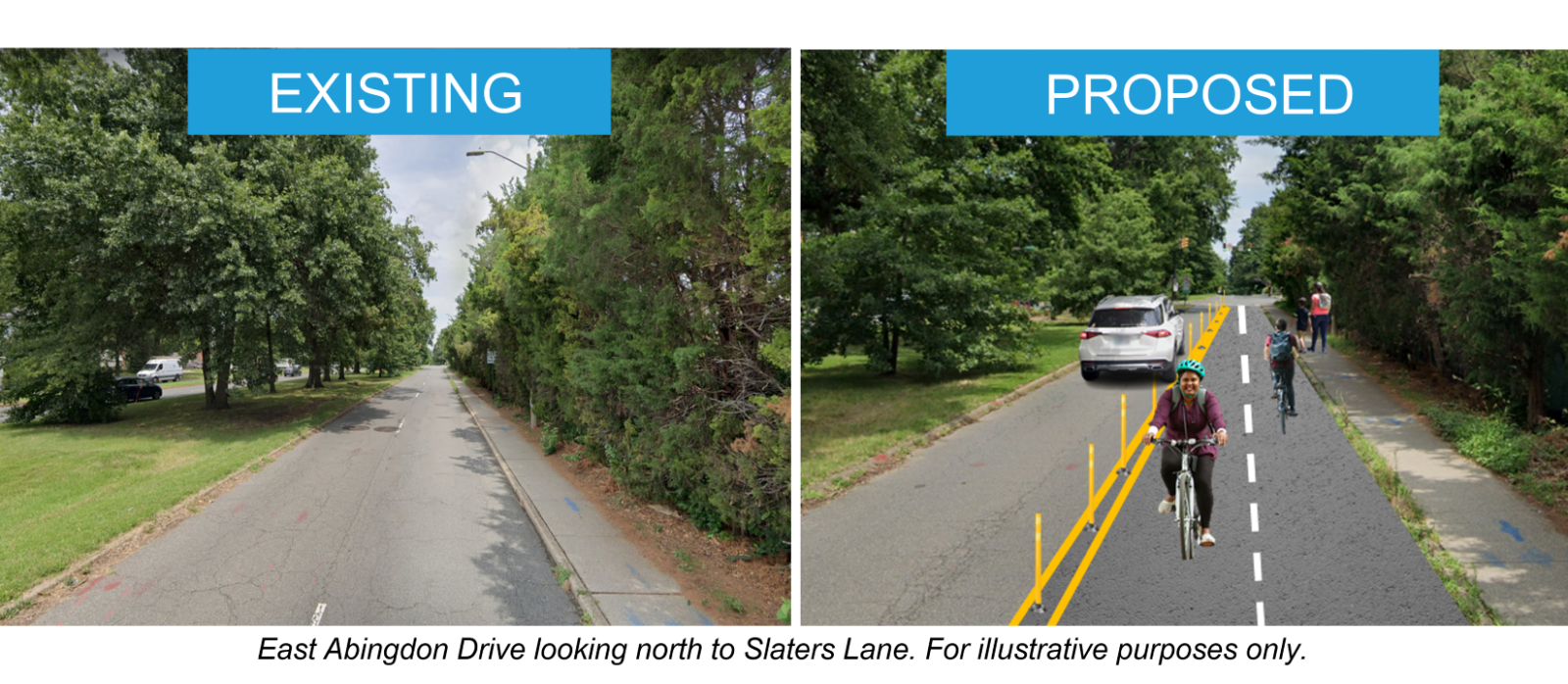
The Friends of the Mount Vernon Trail is rallying support to get a section of roadway into Old Town North converted into a bike lane.
The plan would be to take the right lane of East Abingdon Drive — which runs parallel to the George Washington Memorial Parkway — and convert it into a two-way buffered cycletrack connected to the Mount Vernon Trail, Patch first reported.
The Mount Vernon Trail branches just north of Old Town, with one part continuing along the waterfront and the other leading onto E. Abingdon Drive. The section on East Abingdon Drive, however, requires cyclists to either ride in the street or on a narrow sidewalk.
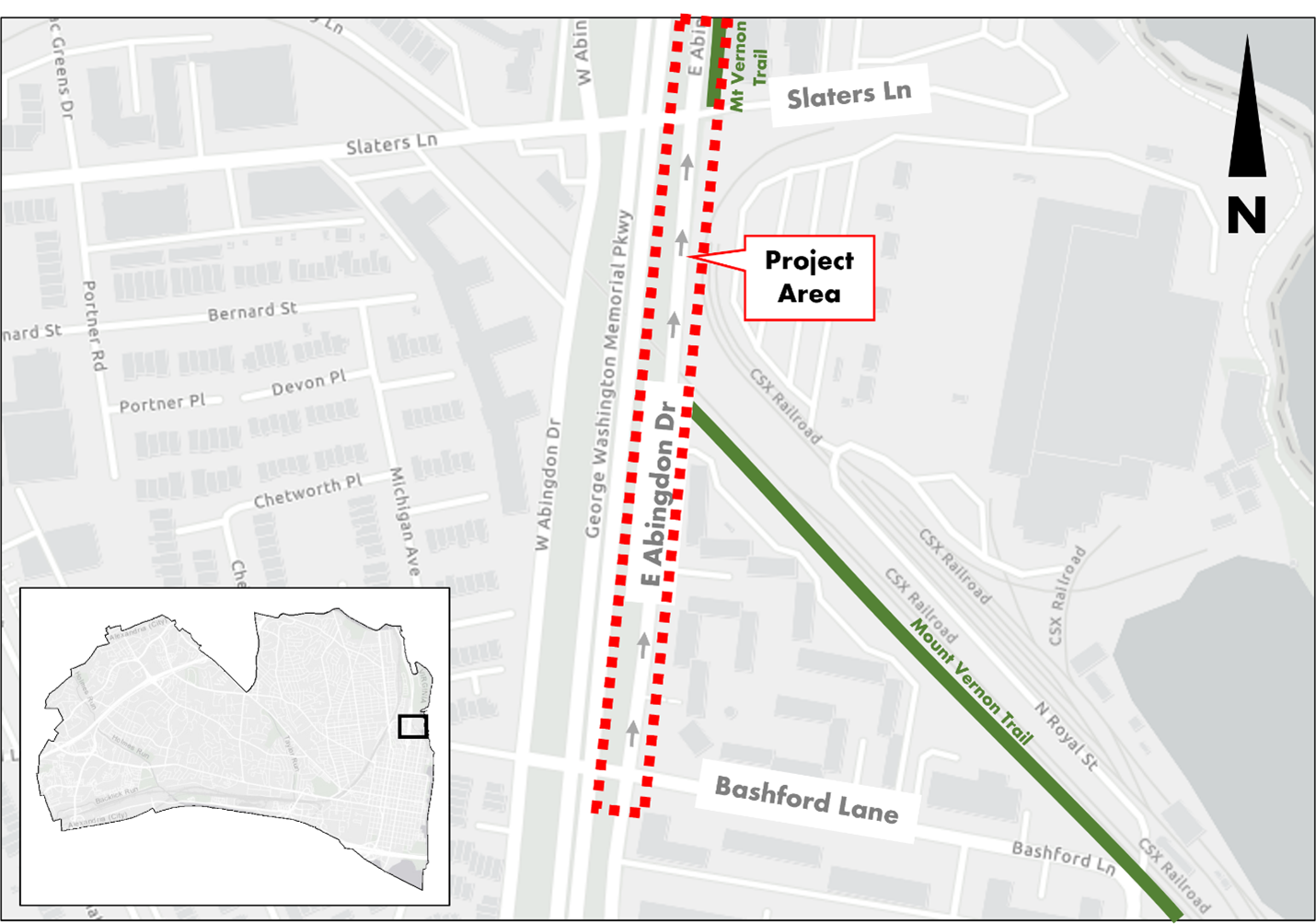
“Currently, trail users are advised to use the narrow 4-foot wide sidewalk,” Friends of the Mount Vernon Trail wrote. “On one side, is two lanes of automobile traffic, on the other is a row of cedar trees. Two trail users can not comfortably pass each other in such a narrow space. While northbound cyclists can legally use the street, southbound cyclists would be going against traffic.”
Bike lanes are also being considered at King Street near the Bradlee Shopping Center, on Eisenhower Avenue, and on Holland Lane.
Feedback on the proposal can be submitted online by Sunday, Sept. 17. The project is headed to the Alexandria Traffic and Parking Board on Oct. 23.
Help improve the Mount Vernon Trail by letting the city of Alexandria know that you support Option 2 of the East Abingdon Drive Bike Lane Project. Provide feedback by September 17
Read more here: https://t.co/VzqWBscJFX pic.twitter.com/lHUCzMoVfu— Friends of the Mount Vernon Trail (@MtVernonFriends) September 10, 2023
The City of Alexandria is looking at adding protected bike lanes (page 21) to Eisenhower Avenue and South Pickett Street in the Van Dorn neighborhood.
A report to the Transportation Commission last week reviewed some of the plans for adding protected bike lanes around the city. The plan, as recommended in the Complete Streets Five-Year Plan reviewed in June, includes adding these new bike lanes sometime in the next five years.
Protected bike lanes are facilities that are fully separated from vehicular traffic with a physical divider, like a curb, bollards or planters.
The protected bike lanes would run on:
- South Pickett Street (from Duke Street to Edsall Road)
- Eisenhower Avenue (from South Van Dorn Street to Holmes Run Parkway)
While that stretch of Eisenhower has traditionally been industrial areas and small clusters of local businesses, the area is gradually urbanizing with large swaths of new residential development planned.
According to a report filed at the Transportation Commission:
Staff have taken steps aimed to streamline decision-making regarding bicycle lane design and implementation. The adoption of the Curbside Prioritization Framework in the Alexandria Mobility Plan (AMP) helps staff identify where bike lanes would be a high priority. As part of this framework, bike lanes, among other items included in City plans, were identified as the highest priority use in all land use contexts.
The report said protected bike lanes are an important strategy for meeting the needs of riders of all ages and abilities.
Bike lanes have not always been fondly received in Alexandria: bike lanes were paired with a road diet on Seminary Road that stirred up some local controversy in 2019.
Image via Google Maps
Update at 4:50 p.m. — A spokesperson for the City of Alexandria said the city is not “proposing” bike lanes, but that bike lanes are one of several options being considered for North Beauregard Street.
T&ES feels the article is still misleading and not providing accurate information. We request you change the headline to reflect the actual input we are asking from the community.
To clarify, at T&ES we conduct feedback for several streets on the repaving list every year to adhere to the City’s Complete Streets Policy and Beauregard is no exception. Beauregard is scheduled for repaving this year and we are soliciting feedback on ways to make the stretch of road safe for all users, including people that drive, ride transit, walk, and bike. Bike lanes are not being considered or proposed here because the Beauregard Trail CIP project will provide a shared-use path adjacent to Beauregard with bicycle and pedestrian connections to other areas of the City. Further, staff has not developed any design nor proposed potential improvements for the street thus far. Safety improvements will be based on the feedback we’ll receive from the community and safety best practices.
Earlier: Buckle up, here we go again.
The City of Alexandria is looking for public feedback on a plan to repave North Beauregard Street and — potentially — add new bike lanes, along with curb ramps, upgrade crosswalks, and more.
The planned repaving would run along North Beauregard Street from Seminary Road to King Street near Northern Virginia Community College. The street is primarily two lanes in each direction for most of that .8 mile stretch.
Part of the Complete Streets policy adopted by Alexandria in 2011 requires improved accessibility of city streets that, along with other plans like Vision Zero, means added infrastructure for pedestrian and cyclists.
The rollout of that plan has been occasionally contentious, to say the least. A political faction of civic activists arose out of a Facebook page that started with opposition to bike lanes installed on Seminary Road as its rallying cry, though the bike lanes had their fair share of ardent defenders as well.
Proposed changes to the street, according to the city, include:
- Add or upgrade curb ramps
- Add or upgrade pedestrian crosswalks
- Improve roadway signage
- Add bicycle facilities, such as bike lanes or shared-lane markings
- Additional pedestrian crossing treatments
- Minor signal timing changes
Locals are encouraged to submit their feedback online by Friday, March 26th.
Image via Google Maps
Seminary Road has seen delays beyond standard reconstruction work as the city implements the new Complete Streets configuration, according to a staff memo to City Council.
The plan takes the four lanes on Seminary Road from N. Howard Street to N. Quaker Lane down to one travel lane in each direction and a turn lane also accessible to emergency vehicles. The change allows for a new bicycle lane to be placed on the street, part of a push to make Alexandria more accessible to non-vehicle forms of transportation — and a broader effort called Vision Zero to reduce or eliminate traffic fatalities.
The plan has been controversial, with advocates arguing that the change right-sizes transportation uses to make the streets safer and more accessible to cyclists, while critics said the plan will create further congestion for drivers.
In a memo to the City Council, Hillary Orr, deputy director of Transportation and Environmental Services (T&ES), said that the paving of Seminary Road has been completed and crews are now working on implementing the road reconfiguration, but the street has seen additional traffic delays in the month since the project started.
“While we understand that delays are frustrating, the corridor is still under construction and all of the components that work together to make this project work are not yet complete,” Orr said. “While there have been some increased queues during the peak half-hour in the morning, we are still generally seeing vehicles able to get through a signal in one cycle. The evening peak is a bit longer, and we have seen some delays between 5:30-6:30 p.m., with 6-6:15 p.m. as the peak.”
Orr said other delays have been caused by the disconnection of signal hardware that tells traffic lights when there are vehicles on the roads. Once paving was completed, Orr said these were reinstalled and reconnected and those delays have eased.
“With any road reconstruction and design reconfiguration, delays are to be expected while the project is implemented and motorists get used to new traffic patterns,” Orr said. “This is one example of how construction impacts travel times, and there are numerous other instances that occurred this week and caused residents to reach out regarding delays.”
If you were one of the people caught on Seminary Road last Thursday (Nov. 7), Orr said the delays were part of a spike in traffic throughout the region.
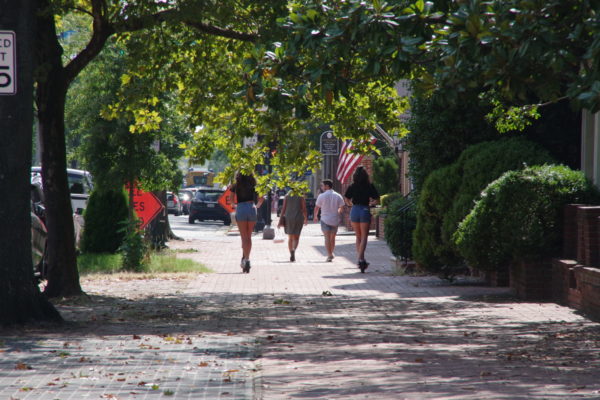
As Alexandria readies updates for its city-wide transportation plan, the city opened up the floor to other local government experts for lessons learned.
During a community forum last night (Monday) about Alexandria’s new transportation plan, city staffers hosted transit leaders from D.C. to Columbus, Ohio for a discussion on what Alexandria should focus on.
“This is a really exciting time to be in transportation,” said Director of Transportation and Environmental Services (TES) head Yon Lambert, who referenced the projects to build a new Metro station entrance at Potomac Yard, as well as Amazon’s headquarters and the new Virginia Tech campus.
Scooters Are Here to Stay
One new feature of the upcoming master transit plan, renamed “Mobility Plan,” will be the e-scooter program City Council members are considering expanding.
“When they first started they were like big toys,” said Jordan Davis, who heads the Smart Columbus smart city program in Columbus, Ohio and who noted that nowadays many people are using scooters for practical, routine trips. “So I think they’re here to stay.”
When asked by the moderator, about half the 80-member audience indicated they had used e-scooters and e-bikes.
(Data) Sharing is Caring
TES Principal Planner Jennifer Slesinger said one part of the new master plan will focus on smart mobility. Panelists encouraged planners to make real-time data a part of that.
Davis said said if cities publish provide real-time road condition data, navigation apps like Waze or Google Maps can help cut down on cut-through traffic — like the kind experienced on Taylor Run Parkway, Duke Street, and Seminary Road.
Hillary Orr, Alexandria’s Deputy Director of Transportation, previously told WTOP that the city plans to redirect cars out of neighborhoods and back to “arterial” roadways, and use sensor technology to allow buses longer green light time to prioritize transit riders.
Linda Bailey, who leads D.C. Department of Transportation’s embattled Vision Zero initiative, said real-time data could also allow cities to set up systems where delivery trucks can reserve and pre-pay for curb parking, and drivers can also tap into information about local parking garages.
“I have seen a parking garage that is never full just around the corner here,” she said of the Carlyle Place parking garage, adding that “information gaps” are one of the things technology addresses well.
You Can’t “Build” Away Congestion, But You Can Build Safety
Several panelists echoed the famous phrase that planners can’t “build” their way out of congestion problems.
“The only way out of our congestion is to get out of our single-occupancy vehicles,” said Atherton.
When residents asked what role ride hailing companies play in this, considering some studies show they increase road congestion, ride sharing service Via’s Greater D.C. Area General Manager said he’s “in favor” of congestion taxes like New York City’s new cruising tax to encourage more shared rides rather than single-passenger trips.
But experts said safety could be built: Atherton noted some simple solutions like sidewalks are “pretty nuts and bolts.” Bailey said keeping roads narrow and building fixtures like poles in people’s peripheral vision encourages motorists to drive slower.
The D.C. officials said everyone needs to “remember physics.”
“We need to look at force and mass in order to avoid and mitigate crashes to keep people safe,” she said.
Alexandria released a public survey this summer to guide the plans, which will last another decade, as Alexandria Living reported. Posters shared during Monday night’s meeting indicate that the new plan is being designed around the survey responses, in which residents asked for “safety, accessibility, and ease” in their transit modes.
But don’t hold your breath to see the new document: planning discussions are expected to continue into Spring 2020.


